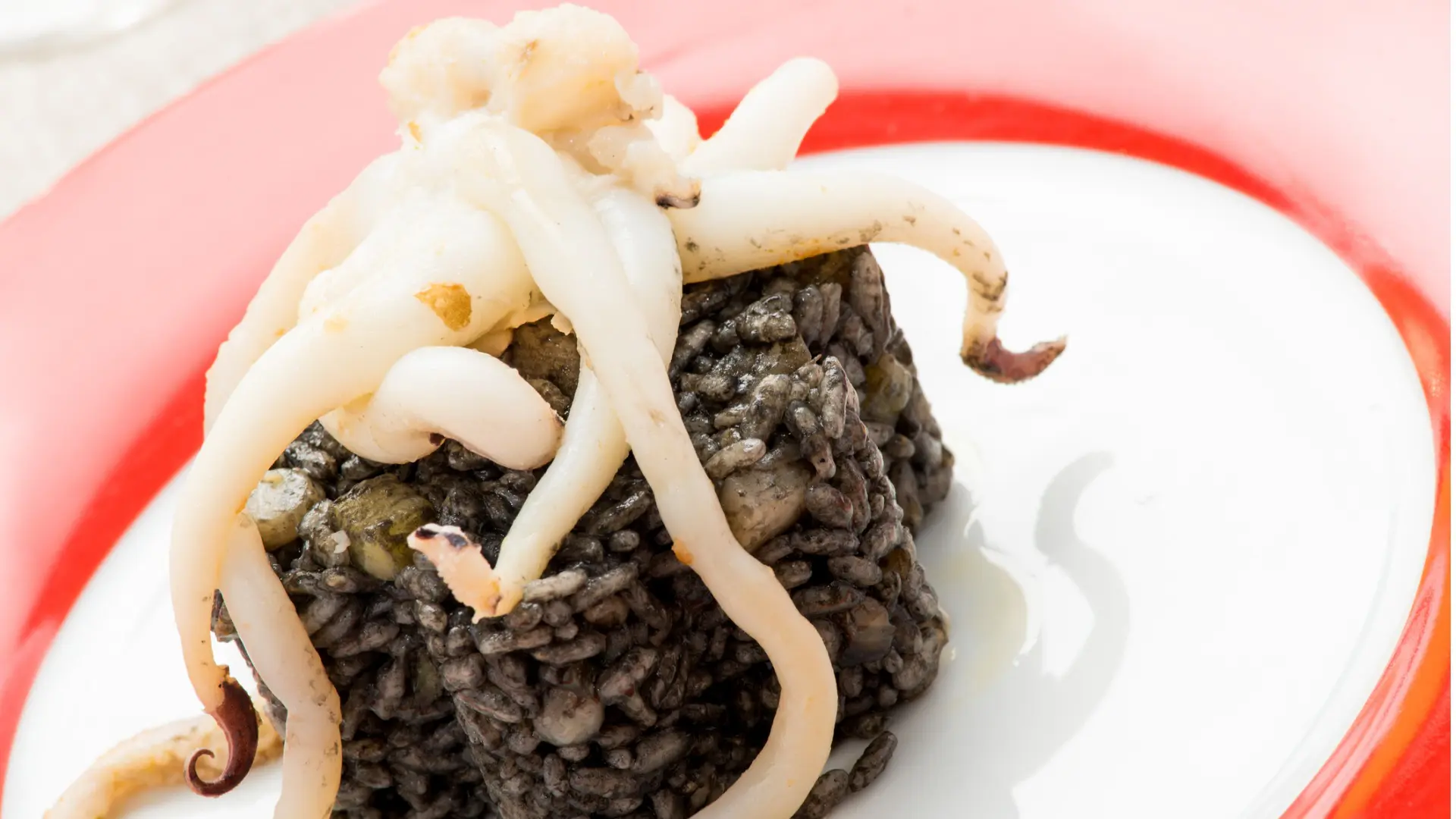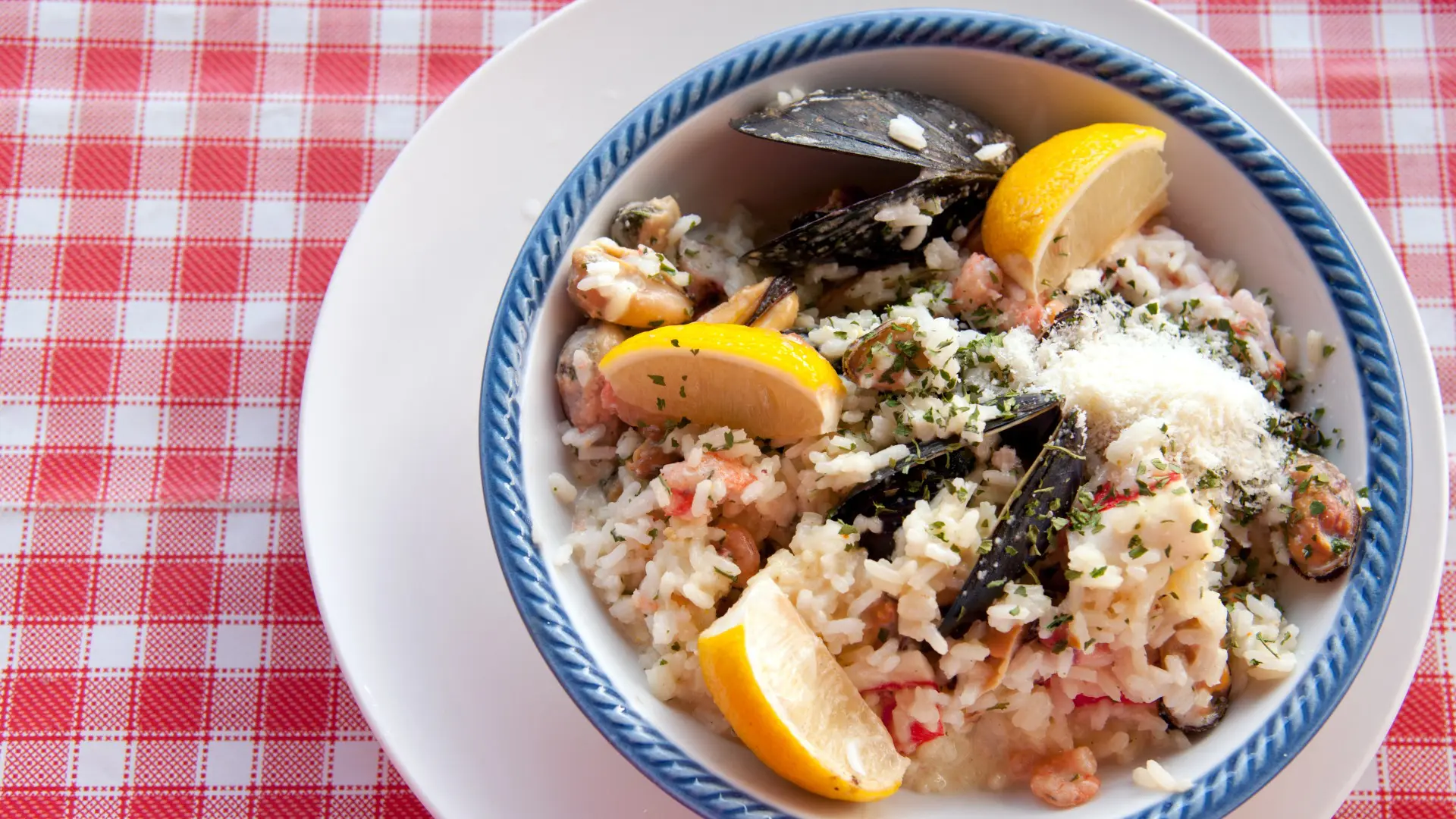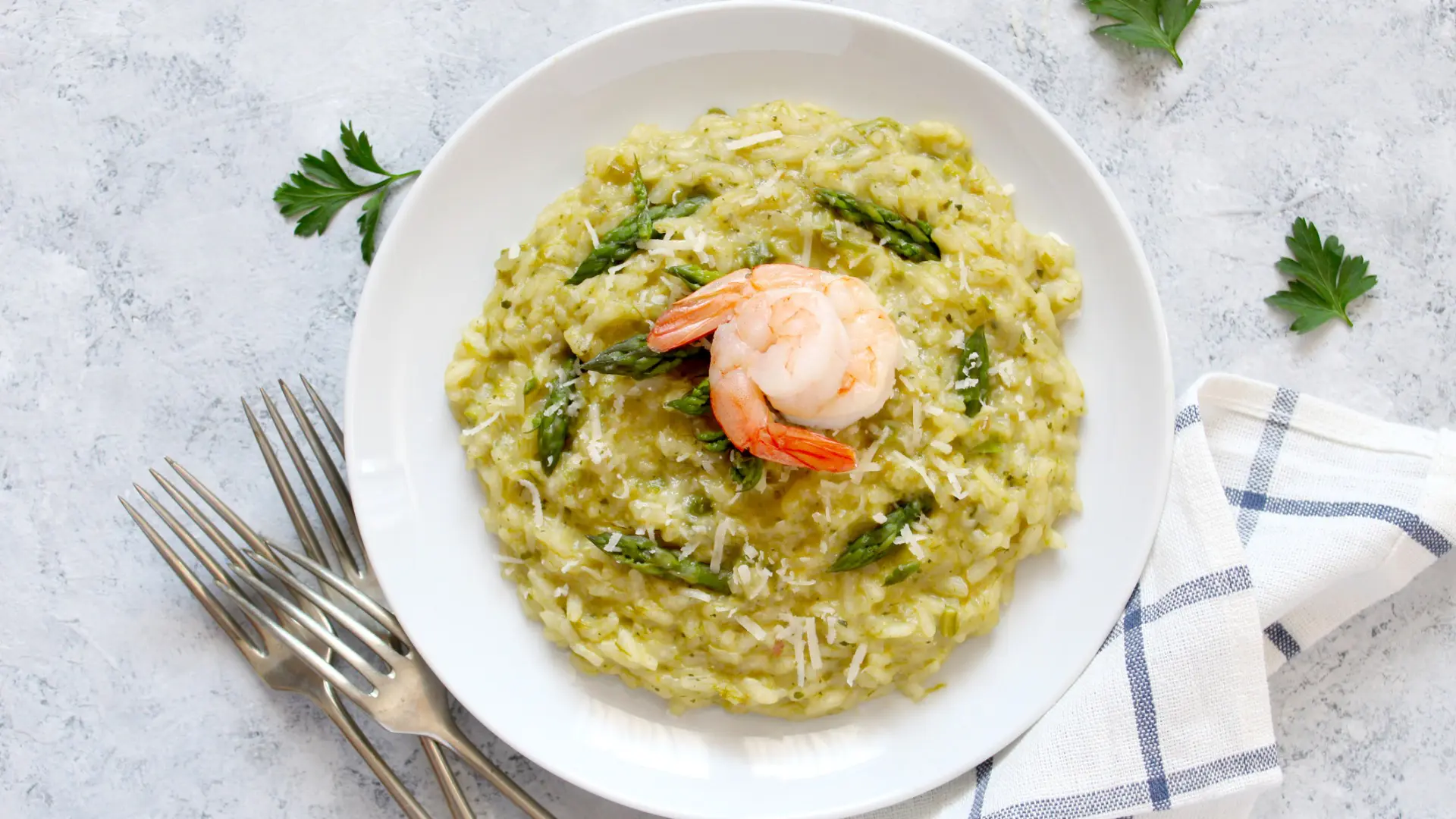One of the most popular foods worldwide is rice, and Croatia couldn’t be an exception, as Croatian risotto is a staple in our local cuisine. Croatia’s gastronomical heritage is intertwined with the country’s history. During the long and turbulent periods under Ottoman rule, the invaders established their distinct culture in the lands they conquered. Among other things, rice was one of the Ottomans’ contributions to the Balkans, including Croatia.
In Croatia, rice is often paired with seafood and fish, rendering dishes with light, Mediterranean flavors. However, alongside seafood risotto, there are also some other risotto recipes, deeply rooted in local gastronomy. Let’s have a look at the various types of Croatian risotto you can try during your trip to Croatia.
Jump to a section of this article
Crni Rižot (Black Risotto)
Black risotto is probably the most famous Croatian risotto. To make a delicious black risotto, you need good quality rice and small cuttlefish from the Adriatic Sea. The perfect Croatian risotto requires starchy short-grain rice. Most frequently, we use arborio or carnaroli rice here in Croatia. The main risotto philosophy is that it needs to be creamy but at the same time cooked al dente. This is why not all types of rice are suitable for risotto.
The second most important ingredient for our black risotto is the cuttlefish. But again, not just any cuttlefish! The star of this black risotto is the small cuttlefish found in the Adriatic Sea that usually weigh around 6.6 pounds. Adriatic cuttlefish have a less chewy texture than their ocean counterparts, giving the risotto a very light taste.
There are several recipes for black risotto, often passed on from one generation to the next. Some Croatian risottos are more famous than others, such as the black risotto from Ston, a small town in the Peljesac Peninsula. No matter if you are an expert or making Croatian risotto for the first time, it shouldn’t take you more than 40 minutes to make black risotto if you have the right ingredients. The trickiest part is taking the black ink from the cuttlefish, as that is where the black color of this risotto comes from. If you are not experienced in cleaning cuttlefish, we suggest asking for assistance at the fish market.
Other ingredients needed for this dish are olive oil, garlic, parsley, fish stock, wine, cognac, vinegar, salt, pepper, and Mediterranean herbs, such as rosemary and thyme. Don’t forget the final touch that makes all the difference. When the risotto is ready to be taken off the stove, one small butter cube will give it that silky, creamy touch. Some will say that you need to grate Parmigiano cheese before eating. However, in Croatia, we believe that Parmigiano is only needed only when the black risotto is not good enough, so the cheese is mostly there to mask the taste. Take that as you will.

Rižot s Morskim Plodovima (Seafood Risotto)
The main competition for black risotto in Croatia is the seafood risotto. There is an ongoing dispute among locals as to which one is better, with neither ever truly coming out on top. In any case, the two main ingredients for black risotto also apply to seafood risotto. Good quality rice and fresh seafood straight from the Adriatic Sea are must-haves to prepare the most delicious seafood risotto.
The Adriatic Sea is known for its abundance of seafood and fish species. Almost every traditional family in Croatia owns a small fishing boat, and the fishing tradition is passed on from generation to generation. But for those who are not lucky enough to have a family boat, several seafood varieties are usually available at the local fish markets. In particular, fresh calamari, scampi, and mixed shellfish are the best types of seafood to create a typically Croatian seafood risotto, alongside good-quality, starchy short-grain rice.
The rest of the ingredients are more or less the same as in the black risotto. The final choice and quantity depend on each cook individually, thus allowing for some personal creativity. At the end of the day, cooking is all about creativity, and tradition and creativity have always blended perfectly in this small corner of the world!

Kvarnerski Rižot sa Škampima i Šparogama (Risotto with Kvarner Scampi and Wild Asparagus)
Every spring, caterers from the Istria and Kvarner regions compete for the most delicious risotto with wild asparagus and scampi caught in the Kvarner Gulf, where the best Adriatic scampi, known for their thin shell, pale red color, and very juicy meat, are found. Unfortunately, scampi from Kvarner are less and less available due to overfishing. Nowadays, they have an almost cult-like status.
Another main ingredient for this particular risotto is the seasonal wild asparagus, which is available from early April through late June. Of course, this risotto can be made with cultivated asparagus too, but locals always favor the wild asparagus over the cultivated ones. The secret to wild asparagus is that not all of it is edible. We only use the middle and upper part that nicely cracks under your fingers. Due to the widely known healing properties of wild asparagus, their price is constantly increasing.
It takes the shortest time to make this risotto, about 20 minutes. Preparing the rice first by separately frying it in oil and onion and then cooking it by slowly adding vegetable stock and white wine is key to the success of this specific Croatian risotto. Just before the rice is cooked through, the asparagus and scampi should be prepared together in another pot, on high heat for a short time. Don’t forget to sprinkle the risotto with fragrant Mediterranean herbs. Once mixed with the shrimp and asparagus, you should give the rice another five to ten minutes of cooking time, if you can wait that long, so that all the ingredients blend into a delicious whole.

Rižot s Tartufima (Risotto with Truffles)
Together with Piemonte in Italy and Perigord in France, the Istria region of Croatia is home to the world’s most prestigious truffles. Thanks to its humid soil, the Motovun Forest is the proud home of both white and black truffles. While white truffles are available only for a short period from September to December, black truffles can be found all year long.
As truffles grow underground, they are hard to find. Nowadays, locals mainly use dogs to help uncover these elusive fungi. Historically, pigs were used as truffle hunters instead of dogs. But people quickly had to come up with a better solution as pigs would not only find the truffles but also eat them! Dogs proved to be much more loyal to their human companions in this regard. They are perfectly happy with a pat on the head as a reward for their hard work.
Among the various delicious dishes made with truffles, Croatian risotto with truffles is probably the most widespread in the region. A lot of hard work goes into preparing risotto with truffles, but this dish can be the ultimate gastronomic experience in Croatia. Similar to the previous recipe, the rice should be prepared first by quickly frying it in olive oil and onion, and then cooked by slowly adding vegetable or chicken stock. When the rice is almost done, it is time to add the butter, truffle butter, and freshly grated Parmigiano cheese, gently mixing it all.
Before serving, fresh truffles should be thinly grated and spread on top of the risotto. Even the smallest quantity of truffle butter and truffle leaves can highlight this dish with the unique flavors of the truffle. For locals, risotto with truffles is the best Croatian risotto of all.

Skradinski Rižot (Risotto from Skradin)
The fun fact about our last risotto is that, throughout history, it was cooked predominantly by men rather than women, as, historically, men were the main cooks in Croatian households. This risotto takes about six to eight hours to prepare, as it is made with slow-cooked veal. This is why Skradin risotto is so special. Stewing the meat is a dedicated task, but also a privilege. Traditionally, housewives always had more daily chores assigned to them apart from cooking dinner, while men didn’t like to be rushed when cooking. This allowed them enough time to create some really amazing dishes. And that is what Skradin risotto really is, an authentic gastronomy delight of the entire region!
As its name suggests, our veal risotto is a specialty in the small town of Skradin on the Krka River. Not so long ago, if you wanted to try risotto from Skradin, you needed to plan your time well, announcing your visit at least one day in advance. With the recent expansion of tourism though, local cooks make sure they always have freshly cooked veal stew that they can easily heat and mix with rice just before serving it at your table.
There is no big secret about making Skradin risotto. All you need is a solid veal top round, and meat stock made of mixed meats, preferably a combination of chicken and beef. And, of course, plenty of time. In the course of eight hours and as you constantly and slowly add meat stock, the veal and onions become very soft and juicy. The delightful aromas of nutmeg and mature sheep cheese added at the end also contribute to this splendid dish, whose fame is known outside of the Croatian territory.
Croatian Risotto, Wine, and Memories
No matter which Croatian risotto you choose to try during your visit to our beautiful country, don’t forget to pair it with a glass of superb local wine. And if you want to create the best memories from your trip to Croatia, let us plan for you the most memorable vacation in Croatia, a country that has a lot of treasures in store for those that choose to explore its wonders.

Josipa comes to us with a strong background in the tourism business in Dubrovnik. With us, she returned to one of her favorite roles, direct contact with guests, after several years in sales roles with one of Dubrovnik’s larger high-end hotels. Although Josipa was not born in Dubrovnik, she finished her studies and started her family life here and she feels Dubrovnik to be her hometown. She knows the best places in the city and the surrounding countryside, which she loves visiting with her family. If you’re starting your trip in Dubrovnik, Josipa will greet you upon arrival and will be your local contact, via the cellphone we provide, throughout your trip.